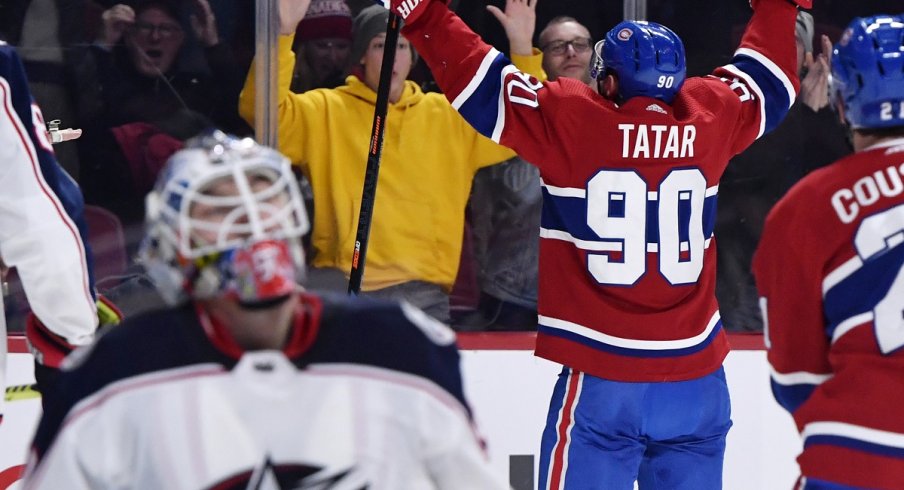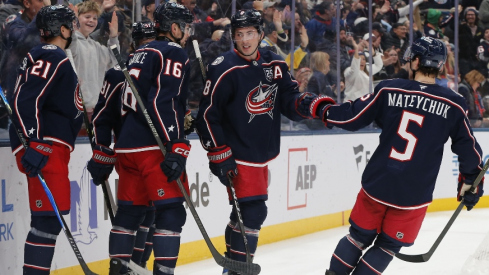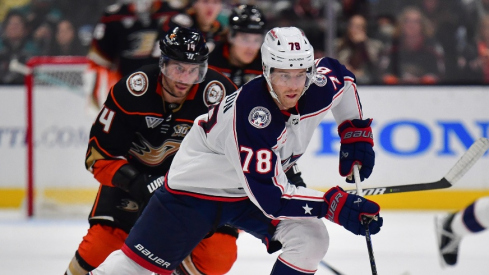The Columbus Blue Jackets went into this season with a lot of question marks. But ultimately, those many questions can be boiled down to a few big ones:
- Would they be able to replace their key UFAs on the offensive side of the puck?
- Would Joonas Korpisalo and/or Elvis Merzlikins be able to make everyone forget about Sergei Bobrovsky?
- Would their defense become/remain one of the top units in the league?
Now that we're at the 30-game poll, let's assess.
No, No, and Yes.
It's no secret that scoring has been a huge concern all year for the club - their 6.5% shooting percentage (5v5) ranks 30th in the NHL, besting only the (potentially historically bad) Detroit Red Wings (5.92%). The offense has been anemic for most of the year, and that's nothing new. But instead of beating a dead horse, let's turn to the defensive side of the puck for today; namely, let's discuss the battery that makes up the goaltenders and the defense corps in an attempt to help further explain their 12-14-4 record.
The Blue Jackets knew coming into the season that they would have to rely heavily on a deep and experienced group of defensemen. It was the one unit that had a surplus of quality players (when healthy), particularly with the emergence of Vladislav Gavrikov as a mainstay. Seth Jones, Zach Werenski, David Savard, Ryan Murray, and Markus Nutivaara, Dean Kukan and Scott Harrington round out one of the most formidable and complete defense corps in the NHL.
Even when the injury bug came and forced Werenski and Nutivaara out of the lineup, rookie Andrew Peeke earned a promotion and has shown well in his first stint in the NHL. The team's issues really don't pertain to the defense. Some evidence:
The Blue Jackets are among the best teams in the NHL at not gifting their opponents' quality looks. At 5v5, the club gives up just 29.33 shots on goal against per 60, eighth-best in the NHL, per NaturalStatTrick. But not all shots are created equal. To that end, the club ranks second in the NHL in high-danger chances-against/60, to the tune of allowing just 8.28 chances/game. At all strengths, their 2.24 expected goals against/60 minutes (xGA/60) is best in the NHL. And at 5v5, the Blue Jackets xGA/60 1.94 goals/game is tied for second-best, behind only the Pittsburgh Penguins.
Simply put, the Blue Jackets do not give up many chances, and when they do, they're not typically from the most dangerous areas on the ice.
Sounds like a recipe for success, right?
Well, yes, if your expected goals against match your actual goals given up, or you put the puck in the opposition's net with any sort of regularity. So to answer my own question: no.
Korpisalo and Merzlikins have been fine, but that's just it. Before the season started, I would venture to guess that most of you (and certainly I) would have been okay knowing that, at the 30-game mark, the Blue Jackets 5v5 save percentage ranks tied for 16th in the NHL. Is that great? No, but it's also kind of hard to say that the team is sub-.500 because of them, right? I mean, for those of us who have watched this struggle to score since day one, Korpisalo/Merzlikins have consistently been keeping the club in games, particularly as we've gotten deeper into the season.
This is where it gets tricky. Yes the offense has been invisible, but the Blue Jackets are giving up nearly a goal a game more than expected (all situations GA/60 = 3.04 (19th) vs. xGA/60 2.24 (1st)). Their all-situations save percentage is 24th. And even though their 5v5 save percentage (remember, ranked 16th) sounds fine, it's often the margin between winning and losing.
NaturalStatTrick isn't the only outfitter that has higher expectations for the Blue Jackets' goalie battery. Hockey-Reference utilizes a metric called Goals Saved Above Average (GSAA), which is exactly what it sounds like. Connor Hellebuyck, Winnipeg's star netminder, currently leads the league with a GSAA of 17.57. There are 62 qualifying goalies, and Merzlikins (-3.77, 43rd) and Korpisalo (-4.37 46) rank well outside of NHL starters. Put another way, Helebuyck has stopped 20+ pucks that Korpisalo/Merzlikins allowed, and the season is roughly 30 games old.
So while the Blue Jackets defense has been as advertised, or even better (even with sustained injuries), the inability to score with any consistency coupled with an average/below average goaltending tandem is the difference between being in the playoff chase and the lottery.
Note: All statistics courtesy of NaturalStatTrick unless stated otherwise.


